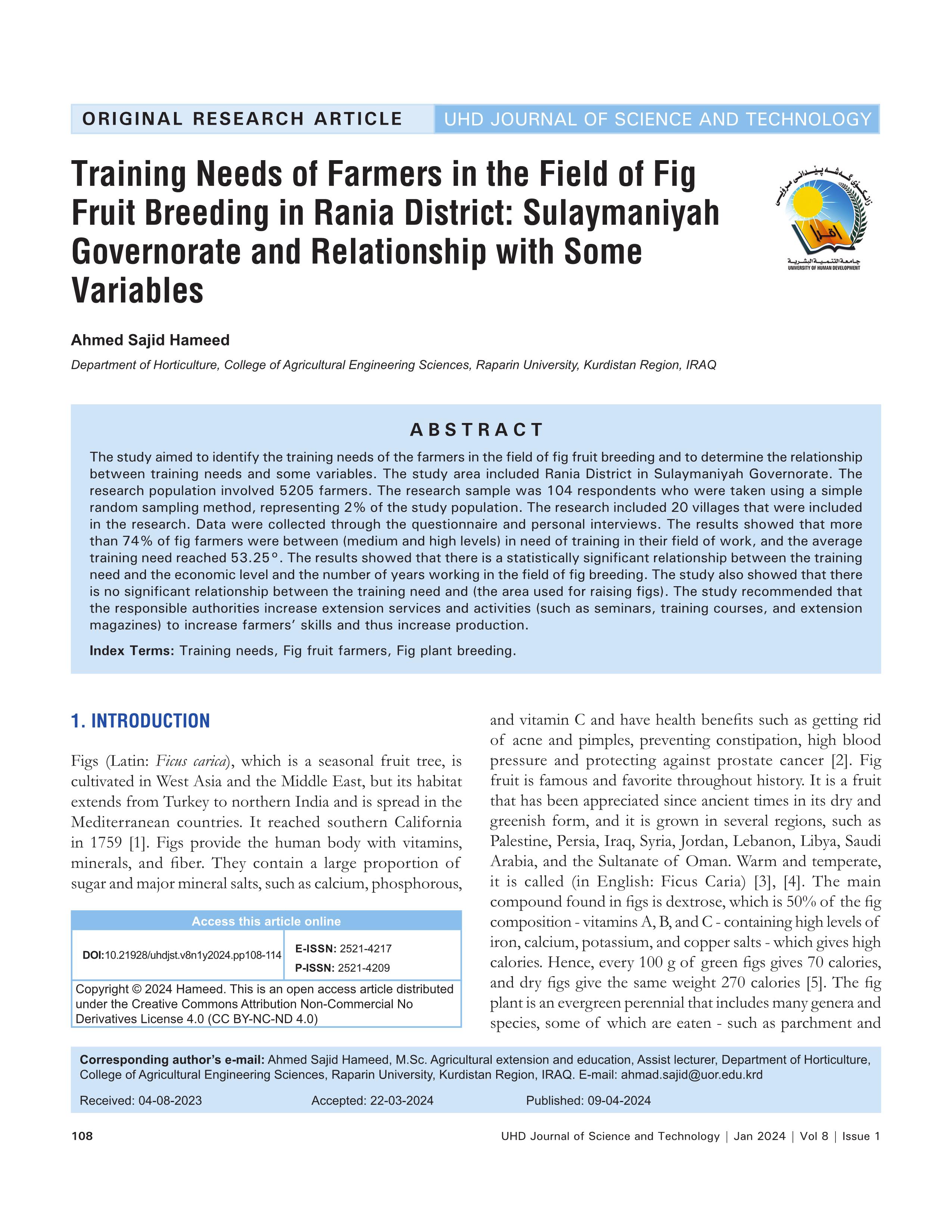Training Needs of Farmers in the Field of Fig Fruit Breeding in Rania District: Sulaymaniyah Governorate and Relationship with Some Variables
DOI:
https://doi.org/10.21928/uhdjst.v8n1y2024.pp108-114Keywords:
Training needs, Fig fruit farmers, Fig plant breedingAbstract
The study aimed to identify the training needs of the farmers in the field of fig fruit breeding and to determine the relationship between training needs and some variables. The study area included Rania District in Sulaymaniyah Governorate. The research population involved 5205 farmers. The research sample was 104 respondents who were taken using a simple random sampling method, representing 2% of the study population. The research included 20 villages that were included in the research. Data were collected through the questionnaire and personal interviews. The results showed that more than 74% of fig farmers were between (medium and high levels) in need of training in their field of work, and the average training need reached 53.25°. The results showed that there is a statistically significant relationship between the training need and the economic level and the number of years working in the field of fig breeding. The study also showed that there is no significant relationship between the training need and (the area used for raising figs). The study recommended that the responsible authorities increase extension services and activities (such as seminars, training courses, and extension magazines) to increase farmers’ skills and thus increase production.
References
P. Alfrey. “All You Need to Know about Figs-Ficus Carica”. Permaculture Magazine, Petersfield, 2019.
J. Carroll. “Fig Types: Different Types of Figs Trees for The Garden”. Gardening Knows How, Dar Al-Kuttab Publishing, Bedford, 2009.
M. E. Kislev, A. Hartmann and O. Bar-Yosef. “Early domesticated fig in the Jordan Valley”. Science, vol. 312, no. 5778, pp. 1372- 1374, 2007.
J. Dixon, A. Gulliver and D. Gibbon. “Global Farming Systems Study: Challenges and Priorities to 2030”. World Bank, FAO, Rome, 2001.
V. P. Vikas and S. C. Bhangale and V. R. Patil. “Evaluation of anti-pyretic potential of Ficus carica leaves”. International Journal of Pharmaceutical Sciences Review and Research, vol. 2, no. 2, pp. 151-155, 2013.
M. Hayek. “Encyclopedia of Medicinal Plants (in Arabic, English, French, German, and Latin)”. Library of Lebanon Publishers, Beirut, 2001.
W. J. Ma, Y. Q. Peng, D. R. Yang and J. M. Guan. “Coevolution of Reproductive Characteristics in Three Dioecious Fig Species and their Pollinator Wasps”. Academic Press, New York, 2009.
F. N. Briggs and P. F. Konwles. “Introduction to Plant Breeding”. Reinhold, New York, 2000.
S. Lev-Yadun, G. Ne’eman, S. Abbo, and M. A. Flaishman. “Early domesticated fig in the Jordan Valley”. Science, vol. 314, no. 5806, p. 1683, 2006.
D. J. Cotter and J. N. Walker. “Climate-Humidity for Fig Cultivation”. Freeman, Dallas, 1999.
W. B. Enderud and J. E. Saleeb. “The Fig, Ficus carica Linnaeus: Its Biology, History, Culture, and Utilization”. Jurupa Mountains, USA, 2013.
M. A. Al-Younis. “Social Statistics”. University of Baghdad, Baghdad, 1999.
M. Khairy. “Statistics in Psychological, Educational and Social Research”. Faculty of Arts, Ain Shams University, Abbassia, 2001.
A. Abas. “Principles of Statistics in Education and Psychology”. Al- Aqsa Library, Pakistan, 2002.
A. F. Khalil. “Training Needs for Agricultural Extension Workers in Northern Iraq”. Master’s Thesis. University of Mosul, Iraq, 2007.

Downloads
Published
How to Cite
Issue
Section
License
Copyright (c) 2024 Ahmed Sajid Hameed

This work is licensed under a Creative Commons Attribution-NonCommercial-NoDerivatives 4.0 International License.


